|
TennisOne Lessons Progressions for Effective Volleys Dave Smith, Senior Editor While television makes doubles seem like the unworthy, overlooked step-child of the media world, the truth is the vast majority of recreational and club tennis players predominantly play doubles. The problem, even when doubles is shown on television, is that at the pro level the action is so fast it is difficult for recreational players to relate to the game. Similar to what we witness in singles, the power of the serves and groundstrokes makes it nearly impossible for the average player to comprehend doubles strategies let alone the actual techniques being employed by pro players. As a coach, when I watch recreational and club players involved in a doubles match, I often recognize so many effective things that are relatively easy to do but the players involved either don’t know how or simply don’t understand the basic volley and strategic fundamentals available to them.
The volley, like the serve, is very dependent on the foundational grip. It is well documented in books, videos, and instructional programs that the continental grip is ideal for the volley.The continental grip improves the ability to react quickly with minimal grip changes. This becomes increasingly important as players move up the ladder and encounter better opponents. More advanced opponents are likely to hit harder shots with more spin and trickier angles, forcing players to hit volleys from lower trajectories and often from further back in the court. The problem for players who use eastern grips on the volley is that these grips not only severely limit the ability to defend lower, more dipping shots, they also limit a player’s time to react because of the grip change needed between forehand and backhand volleys. But perhaps even more important, these grips, by their very nature, promote in effective volley technique.
However, for players who do use eastern grips on their volleys all is not lost. They can overcome some of the negative aspects these grips tend to encourage and I will be talking about the ways a players might still achieve high level volley abilities without having to make the change to the continental grip. The first part of this article will talk about the volley for players who are already playing tennis and want to take their current volley skills to the next level. The second part will focus on ideal tennis technique that ALL skilled players use. It is especially important for players who want to start out with the best foundation to build upon if they want to achieve their greatest potential as they continue to play and improve. Yet, even those who have some volley experience may discover that elusive technical tip or technique that is preventing them from improving. General Foundation Concepts Set and Hold Regardless whether a ball is hit to the forehand or backhand side, if a player can integrate this phrase, “Set and Hold,” as they prepare to hit the and then finish the volley, they will be well on their way to creating a consistent and effective technique. What this phrase means is that as a player moves towards a volley shot, they first set the racquet angle to the target they are looking to hit the ball towards. And it doesn't matter if the intension is to hit a sharp angle volley, touch volley, or a driving put-away volley, if you establish the racquet face early, then the only thing left to do is “find the ball”! The problem with many players coming in to the net, is the tendency to take the racquet back too far. This forces them to literally swing the racquet just to re-establish the desired trajectory. Such an action puts a premium on timing and explains why so many players dump even the easiest of volleys into the bottom of the net or rifle them into the back fence on the fly! With players using an eastern forehand or backhand grip, the problem begins when the player turns sideways to receive the volley. These grips set the racquet angle well back behind the forearm, making even the most basic volley position problematic because the turn will force the player to take the racquet too far back. Players with eastern grips have a difficult—if not impossible—time hitting sharp angle volleys. Because these volleys require additional touch (most angle volleys have much less court available). Players with eastern grips are forced to swing the racquet to achieve the necessary angle. This, of course, imparts too much pace to effectively control the angle volley. However, it is not impossible to “Set and Hold” with eastern grips. The angle of the wrist must accommodate the “Set” portion of the phrase and establish the racquet angle. This can help minimize the need to swing as mentioned earlier. The second portion of the volley phrase, “Set and Hold” is to literally “HOLD” the finish of the volley. This concept helps maintain the integrity of both the contact as well as the aim. Many players swing too much through their volleys, a move that often changes the racquet’s hitting surface during contact. By holding the finish, players gain the advantage of “governing” their swing…meaning, they usually won’t “over-swing.” Adding Underspin Once a player has the grip and stroke elements mastered, then we can progress to adding underspin. There are two reasons we look to slice our volleys: The first is to control the pace of the volley. If you are moving forward to volley a hit hard ball, especially one that is dipping low, you must hit the ball on an upward angle to clear the net. If you hit this hard-hit ball flat, you are likely to drive the ball well passed the baseline. By imparting underspin, you can absorb some of the pace and yet still hit the volley with authority without the ball sailing long. The second advantage of underspin relates to those pesky high volleys: Because the racquet tends to move like an upside-down pendulum, we often find ourselves hitting on top of balls in a downward trajectory. If we do this on a ball that is dropping as it comes to us, we will likely hit these balls into the bottom of the net. By slicing the volley slightly, we decrease this propensity of hitting too much down on top of the ball. If we Set an Hold during this sequence, we will limit the chance of hitting this ball long, as well. Technical Elements for an Advanced Foundation Volley Like any skilled activity, the volley has recognized patterns that better players employ. While there are individual and personal idiosyncrasies within these confines, one must understand they are usually subtleties that only embellish the foundation of the stroke. Most players, as they master any skill, will usually personalize that foundation. This is a human condition. When a player learns a proper foundation, evolution usually contributes to the skill. However, when the foundation is flawed, this evolution seldom contributes to the skill. In fact, it usually adapts to accommodate the flaws. That is, it masks the flaws but does little to cure the problem. So every player will want to evaluate their current volley technique and see if it fits within this advanced foundation. Players who usually stagnate or simply have a weak volley are almost always subject to some flaw within their foundation.
Grip and Body PositionAs mentioned earlier, the grip is so important to a high level volley. And the reason for this is because the grip dictates so many other aspects of the overall shot: Contact point, body position, and arm position are all dependent on the grip. Backhand Volley The backhand volley is really an easy anatomical shot to execute. Why people have so much difficulty with it usually has to do with the grip and some misunderstandings about the shot. Arm Position Holding the continental grip in front of the body, when a ball is hit to the backhand side, the simplest move is to just turn sideways. This automatically sets the racquet to be relatively square to the ball. With the eastern grip, the problem begins with the turn — the racquet is always taken too far back when a player turns sideways holding an eastern backhand grip. Now the player is literally forced to swing just to get the racquet orientated to the target. One of the reasons so many 3.0 players tend to “dink” their volleys is because they use an eastern grip. This often causes them to hit too hard and to compensate, they start to decelerate on every volley. The continental grip orientates the racquet to be parallel with forearm of the hitting arm. So, all the player needs to do to hit a firm volley is simply find the ball. Any forward motion with the body or leverage with the arm will add pace will add pace to the ball. The continental grip affords the player options on the backhand side. They can turn less and create a more severe angle volley, or they can turn more, (or simply take their arm back slightly), to drive the ball straight ahead. The other major learning item on the backhand volley is to maintain a straight arm on the take back. If the player bends the arm, the racquet is usually is taken too far back. In addition, bending the arm shortens the length of the lever that the arm provides in hitting a backhand volley.
Two of the major contributors to “Tennis Elbow” is using an eastern backhand grip and bending the elbow when volleying. These two issues put tremendous strain on the elbow. Because the grip causes the racquet to be taken back more, and the bent elbow forces the player to try and straighten the elbow to get the racquet back to square, contact often occurs late. This late hit can strain the tendon at the epicondyle which causes tennis elbow. Because the arm position is across the body as we turn for the backhand volley, we naturally have our eyes relatively close to the ball. To add consistency to the backhand volley, try to keep the racquet as close to eye level as possible. Obviously, this is impossible to accomplish on low and high volleys. However, keeping the racquet head above the wrist both on the forehand and backhand volley will help players maintain a better position to execute the volley when all other elements are employed. When a player drops the racquet head on any volley, the racquet face changes and players can’t execute the foundation elements mentioned. While it is easier to simply drop the racquet to volley a low ball, it is not the way advanced players make more effective volleys, nor is it how they defend more effective shots hit by better opponents.
Contact Point With the continental grip, the contact point is parallel or just slightly out in front of the body. It is NOT way out in front as is often mistaken. (Many instructors like to say, “hit the ball out in front.” This is mainly because of the poor use of eastern grips. In order to even square the racquet up with an eastern grip, the player must make contact much further out in front.) The nice thing again about the continental grip is the player has leverage to hit with force as needed. Eastern grips, force the player to be more fully extended out in front so as to square the racquet up before the ball arrives, hence there is very little leverage left to add to the stroke. Forehand Volley Like the backhand volley, the initial turn to the forehand side immediately sets the racquet square to the court when the continental grip is used. By simply turning more, a player can easily, and with minimal complexity, hit a deeper, driving volley. With less turn, the angle of the racquet naturally is set for a sharp angle. Unlike the backhand volley, the turn on the forehand volley moves the hitting arm and shoulder to the back of the player’s body. Thus, the idea of hitting the ball out in front becomes a more accurate tip. However, we don’t want to overreach the volley towards the net as the player will lose leverage as we talked about on the backhand side.
Get Eyes Closer On the forehand volley, players often get out away from their body too much since the arm position is away from the body on the shot. Better would be to get our eyes physically closer to the ball which will allow for more control. Unlike the backhand, because the elbow doesn’t bend the other way, we actually can keep our hitting arm bent, (which helps bring the eyes closer to the ball, as just mentioned!). Another forehand tip is to keep the elbow close to the side of the body. This not only brings the racquet head closer to the eyes, it facilitates the slice action desired on the volley as mentioned earlier. When a player raises the hitting arm’s elbow away from body, it closes the racquet face. Reflective Angle Typically, for players who “panic” and raise the elbow on the forehand volley or use an eastern forehand grip, the tendency is to hit too flat. If you understand the concept of reflective angles, you will quickly understand how detrimental hitting flat is: In most cases, balls approaching us while we are at the net or approaching the net, are on a downward trajectory. Thus, not taking into account any spin, a ball on a downward incoming angle will reflect downward off a flat surface. If you have an incoming ball with underspin, (incidence angle), it will reflect even more downward off that flat racquet face (reflective angle). Knowing this, we can see why players who are almost on top of the net can often hit balls into the bottom of the net! Add any swing in a downward action, we can really see why balls go so straight down towards the ground. By opening the racquet face up (bevel the racquet open) and driving forward with a slight downward slicing action, players can insure hitting these low-angling balls on an upward trajectory. Obviously, with practice, players will learn how high to aim on various shots. However, if players continue to hit with a flat racquet face, they face the consequence of reflective angles forcing volleys to end up in the net or landing very short. Spin Advantage Many shots hit at us while we are at or approaching the net will be hit with topspin. One of the big advantages of adding slice to the volley is not just to create better reflective angles, but also to apply spin to the ball that it already has. In other words, by slicing an incoming topspin shot, we are spinning the ball off our racquet with the same spin it is coming in with. This makes the volley feel solid as well as adding more slice coming off our racquet.
This spin advantage creates a lower bouncing ball traveling to our opponents. If we are looking to hit an angle volley or want to force our opponents to hit more up on our shots, this slice spin will help both objectives. Angle Volley Drill Once a player starts to familiarize himself with the continental grip and is looking to master it, a few basic drills can increase the player’s ability to use the grip in all situations. Instead of volleying straight over the net to a partner, stand at far sides of the court close to the net. Work on hitting volleys on an extreme sharp crosscourt angle, almost hitting the ball parallel with the net. This drill is perfect for emphasizing the continental grip as well as introducing players to touch and angles. Let it Drop, But don’t let it Bounce
A great drill that not only focuses the player on using the continental grip (since using eastern grips renders this drill nearly impossible to execute), it develops great touch and teaches players not to rush or panic for a volley. The Drill has a player standing very close to the net facing a partner on the other side. Each player hits the ball as close to the net as possible, then letting the ball drop as low as possible, before volleying the ball back up and over close to the net. Try to keep the rally going as close to the net and letting the ball drop as low as possible without letting it bounce. Butterfly Drill This drill is a basic forehand to backhand drill. You and your hitting partner can stand close to the net or a little further off it. Working on hitting alternating forehand and backhand volleys will help players learn to react, to maintain the continental grip, and to control the ball. The drill can be done both straight ahead (as in a down-the-line drill) or crosscourt and even on the sharp angle crosscourt discussed in the first Angle Volley drill. This drill also works great against a backboard for those times when you don't have a hitting partner available — practice forehand and backhand volleys as well ass the butterfly drill..
Conclusion There are many misconceptions associated with the volley. Some of these are promoted by ignorance, others are promoted by misinformation. Phrases like “hit the ball out in front” or “Hit the volley flat” are two of the more common myths that are more associated with very rudimentary play as opposed to techniques that are associated with higher levels of skilled play. Try to understand, practice, and master these instructional ideas and you will be well on your way to progressing to extraordinarily strong net play!
Your comments are welcome. Let us know what you think about Dave Smith's article by emailing us here at TennisOne .
HIDDEN MICKEY 
If you are a fan of anything DISNEY, Dave Smith (better known as Senior Editor for TennisOne and author of two prolific tennis books TENNIS MASTERY & COACHING MASTERY), has just published an exciting and compelling novel, HIDDEN MICKEY. This Action-Adventure story centers around three friends who discover a secret journal penned by the master storyteller himself, Walt Disney. The diary hints at hidden treasure and sends the three friends on a wild cross-country search, following intriguing clue after clue and finding incredible discoveries about the great man, his life...and about themselves. For anyone who loves Disneyland or all things Disney, Hidden Mickey is a MUST READ. Limited First Edition, signed and numbered copies, available.
He is the author of two top-selling tennis books, TENNIS MASTERY & COACHING MASTERY. (http://www.tennis-warehouse.com/Tennis_Mastery_-_Beyond_35_Level_Revised/descpageSGTA-MASTERY2.html) Dave is a Dunlop Sports Master Professional and a USPTA P-1 and has been a featured speaker at numerous divisional and world conventions. In addition, Dave created and authored the popular Disney Mysteries, "Hidden Mickey", adventures about Walt Disney and Disneyland. For over twenty-five years, Dave has published over 400 articles on tennis in magazines, web sites, and for international tennis publications. Today, he owns Synergy Books Publishing and helps authors realize their publishing dreams. For his information, go to www.synergy-books.com. You may also reach Dave at david@synergy-books.com. |
||||||||||||||
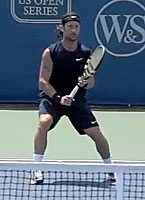
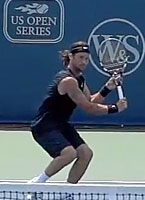
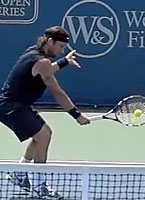
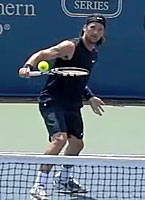
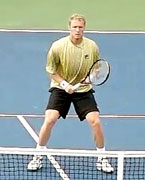
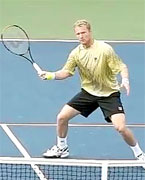
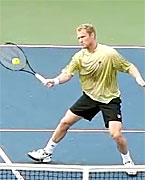
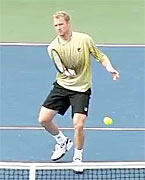 Here Dmitry Tursunov shows how simple the forehand volley can be. The slight shoulder turn (less than what is needed on the backhand volley) literally sets the racquet face with very little arm swing. The racquet face is set early and maintained through impact. While it is hard to recognize, the racquet has a slight down ward swing path. And while Tursunov follows through more than I recommend players who are learning the forehand volley, he is holding his racquet the same relative to his forearm.
Here Dmitry Tursunov shows how simple the forehand volley can be. The slight shoulder turn (less than what is needed on the backhand volley) literally sets the racquet face with very little arm swing. The racquet face is set early and maintained through impact. While it is hard to recognize, the racquet has a slight down ward swing path. And while Tursunov follows through more than I recommend players who are learning the forehand volley, he is holding his racquet the same relative to his forearm.  David W. Smith has been a coach, tennis teaching professional, Director, Head Professional and General Manager of clubs and tennis facilities in California, Arizona and Utah. As a coach, Dave had one of the finest high school team tennis records in the U.S. winning over 800 team matches against fewer than 20 losses in 28 seasons of coaching boys and girls tennis teams.
David W. Smith has been a coach, tennis teaching professional, Director, Head Professional and General Manager of clubs and tennis facilities in California, Arizona and Utah. As a coach, Dave had one of the finest high school team tennis records in the U.S. winning over 800 team matches against fewer than 20 losses in 28 seasons of coaching boys and girls tennis teams.